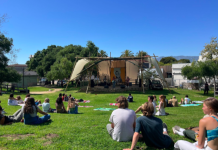Kyle Roe
Staff Writer
Italy is a country known for delicious food, rampant organized crime, and centuries of producing exquisite, world-renowned art. If you’re like me, and probably most of the American public, you don’t know very much about the history of Italian art. The only Italian artist I am even remotely familiar with is Leonardo Da Vinci, which is about the intellectual equivalent of knowing your middle name. The only Italian history I know after the Romans is what I’ve pieced together over the years from Assassin’s Creed games.
Luckily, the Santa Barbara Museum of Art has a cure for our collective historical ignorance through their new traveling exhibition, entitled “Botticelli, Titian, and Beyond: Masterpieces of Italian Painting from Glasgow Museums.” As the title suggests, all the pieces are from the Glasgow Museums Collection and boast styles and artists from all over Italy. They were originally donated by Archibald McLellan, a wealthy 19th century businessman who admired art for its ability to teach moral truths and lessons. His collection reflects his belief in the formative power of art, consisting of paintings portraying everything from biblical tales and Roman history to themes of allegory and sacrifice. The exhibition is especially impressive for its breadth, with artwork ranging from the early Italian Renaissance to the 19th century.
The museum arranged all the paintings by period, with 15th century pieces in the first room and 19th century pieces in the last. The 15th century paintings include Botticelli’s “Annunciation,” a powerfully expressive painting where the Virgin Mary is simultaneously impregnated by the Holy Spirit via a beam of light and visited by the archangel Gabriel. Another highlight of the 15th century section, and the entire exhibit, is Titian’s “Christ and the Adulteress.” The painting is considered one of the early Italian masterpieces and was painted by Titian when he was only 20 years old. The piece depicts a dramatic scene from the Bible, where Jesus is compelled by the Pharisees to help stone an adulterous wife, as was the custom in biblical Israel. Jesus famously responds, “Let he who is without sin cast the first stone,” once again showing McLellan’s affinity for strong moral messages. Christ is famously drawn below all the characters in the scene, even the adulteress; a sign of humility. According to the Independent’s Tom Lubbock, “[‘Christ and the Adulteress’] is also a surface of rich material delights, a quilting of colors and textures, folds and gleams, whose pleasures seem indifferent to subject matter.”
Also on display are Francesco Guardi’s beautiful landscape paintings of his home city of Venice, including “View of San Giorgio Maggiore.” The painting flaunts the magnificent domed structure of San Giorgio Maggiore, precipitously located on a slab of concrete on the edge of the Venetian canal system. Rowers pushing their gondolas are in the foreground, while the background consists of the rest of Venice adjacent to the entrance to the great expanse of the Mediterranean Sea. This offers a great example of Guardi’s imaginative atmospheric style.
However, these are just a few of the brilliant works of art you can see. The entire exhibition is fantastic, every piece of artwork is rich in detail, style, history, and character. Unfortunately it will not stay forever in Santa Barbara, the only West Coast stop on the Glasgow Museum’s tour, so I highly recommend stopping by the Santa Barbara Museum of Art between Feb. 8 and May 3 to check out these classic, historic paintings.
















